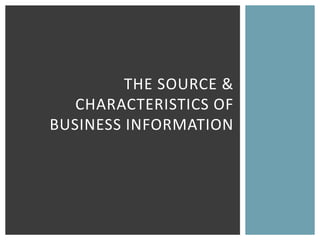
Sources and charactistics of business information
- 1. THE SOURCE & CHARACTERISTICS OF BUSINESS INFORMATION
- 2. DATA Data – is a collection of raw facts and/or figures that have yet been processed, manipulated or interpreted into useful information. Once the data has been processed, it can be considered to be information This information is used by business in the decision making process. The quality of information, the better the decisions that management can make and this can have a major impact on the success or failure of the business.
- 3. INFORMATION Information – is therefore data that has been manipulated so that some meaning can be derived from it
- 4. CHARACTERISTICS Data is therefore processed and becomes information Data Processing Information
- 5. QUALITATIVE DATA Involves data/information that cannot be measured in the usual way. As such, it is usually in some sort of narrative form (spoken or written).
- 6. QUANTITATIVE DATA Is data or information that can be measured numerically and can be proven as fact.
- 7. PRIMARY DATA Is data that you (or your organisation) gathers and interprets yourself. An example might be that you do a survey among your customers about the quality of service your organisation offers This information can be considered reliable because it has been collected at source.
- 8. SECONDARY DATA Would be where another organisation uses the data you have collected and interprets it for other purposes (for example, in a comparison of customer satisfaction for a number of organisations offering the same type of service) This could come from the Internet; written articles in magazines or journals or reported stories. This may not be considered reliable because it could be inaccurate or bias because of the writers point of view.
- 9. CHARACTERISTICS OF GOOD INFORMATION Valid Reliable Timely Fit for purpose Accessible Cost effective Sufficiently accurate Relevant Understandable
- 10. FEATURES OF GOOD INFORMATION Feature Description Explanation Timely Information should be Eg Business final accounts must be available when required prepared in time for shareholders meeting Accurate Information should be Eg accurate market research correct (field) required to make decisions on new products Relevant Information should Eg Prices of similar products may relate to the decision be used to help pricing decisions being made Complete All the information Eg Information on all systems on should be available to the market should be available allow decision to be when deciding which new made computers to buy Up-to- Most recent information Eg using up-to-date ferry should be used timetables when planning business date trip Cost Information should not Field research may be expensive. cost too much to gather Desk research cheaper. Effective
- 11. TASK Create a presentation that discusses the different types of data and also the characteristics of good information in detail